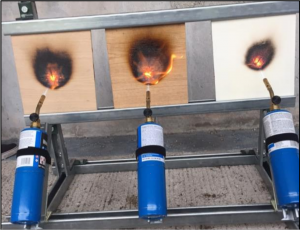Waste and D&D Engineering and Technology Development: Enhancement of Fire Resiliency in Industry Fixatives
Sponsor – DOE-EM
The objective for this research is to improve the operational performance of fixatives by enhancing their fire resiliency. Most fixatives begin to see degradation between 200-400°F, at which time radioisotopes could potentially be released into the environment. Intumescent coatings develop a thick char to insulate the substrate and protect it from fire and extreme heat conditions. The layering or combining of an intumescent coating with the fixative is being investigated as a way to mitigate the release of radioisotopes during fire and/or extreme heat conditions.

At the 2-minute mark: wood only (left) and wood with a leading industry fixative (middle) began to show significant degradation and burn through when exposed to a direct flame. The wood with leading industry fixative layered with an intumescent coating (right) began to develop a thickening char from the expanding intumescent coating.
Benefits:
The layering or combining of an intumescent coating with the fixative is being investigated as a way to mitigate the release of radioisotopes during fire and/or extreme heat conditions.
Accomplishments:
- FIU completed a series of proof-of-principle tests which were designed to expose a selection of fixatives, strippable coatings, and decontamination gels alongside fixatives layered with an intumescent coating to a direct flame source.
- All of the fixatives-only test coupons that were exposed to the direct flame began to display significant degradation in less than two minutes, with some of the fixatives actually igniting and becoming flammable upon contact with a direct flame source.
- The fixatives that were layered with an intumescent coating developed a thickening char
as designed (intumescent coatings, when exposed to an extreme heat source, expand and develop an insulating char), thereby protecting both the fixative and substrate for upwards of 35 minutes from the direct flame.
- FIU has begun the second phase of testing, designed to expose the fixatives and the fixatives layered with intumescent coating on different types of substrates to controlled, incremental extreme heat conditions in a muffle furnace to identify the temperature at which each product or product combination begins to degrade, thus making it vulnerable to a potential release of a radioactive contaminant.
- Preliminary results for the fixatives baselined to date demonstrated significant degradation at temperature ranges between 250-300° F within five minutes of exposure.
